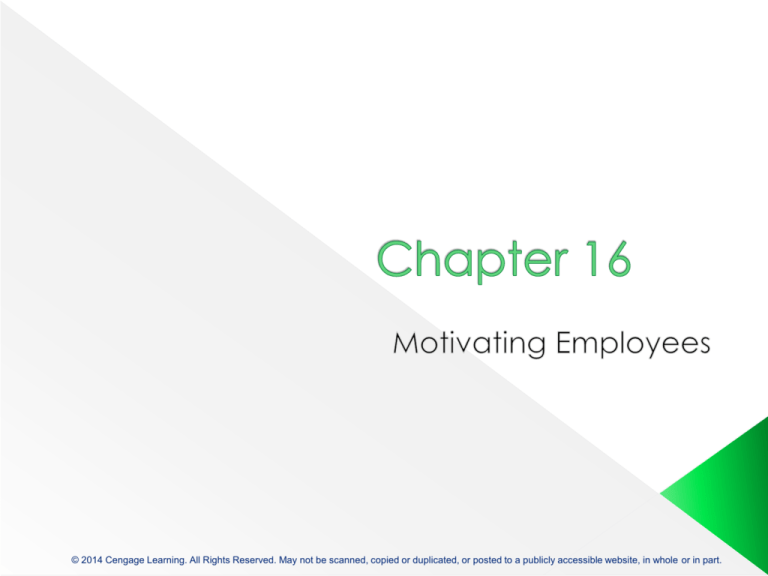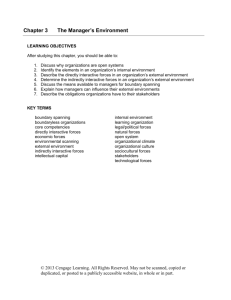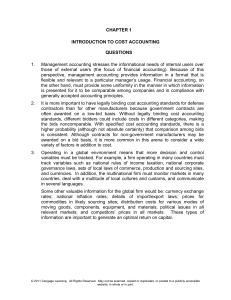
© 2014 Cengage Learning. All Rights Reserved. May not be scanned, copied or duplicated, or posted to a publicly accessible website, in whole or in part.
Motivation – the arousal of enthusiasm and
persistence to pursue a course of action
Forces either intrinsic or extrinsic to a person
that arouse enthusiasm and persistence
Employee motivation affects productivity
A manager’s job is to channel motivation
toward the accomplishment of goals
© 2014 Cengage Learning. All Rights Reserved. May not be scanned, copied or duplicated, or posted to a publicly accessible website, in whole or in part.
2
© 2014 Cengage Learning. All Rights Reserved. May not be scanned, copied or duplicated, or posted to a publicly accessible website, in whole or in part.
3
If managers understand employees’ needs,
they can design appropriate reward systems
Needs motivate people
Needs translate into an internal drive that
motivates behavior
People have a variety of needs
© 2014 Cengage Learning. All Rights Reserved. May not be scanned, copied or duplicated, or posted to a publicly accessible website, in whole or in part.
4
© 2014 Cengage Learning. All Rights Reserved. May not be scanned, copied or duplicated, or posted to a publicly accessible website, in whole or in part.
5
Existence needs – the needs for physical
well-being
Relatedness needs – the needs for
satisfactory relationships with others
Growth needs – the needs that focus on the
development of human potential and the
desire for personal growth
Frustration-regression principle: failure to meet a high-order
need may cause a regression to an already satisfied lowerorder need
© 2014 Cengage Learning. All Rights Reserved. May not be scanned, copied or duplicated, or posted to a publicly accessible website, in whole or in part.
6
© 2014 Cengage Learning. All Rights Reserved. May not be scanned, copied or duplicated, or posted to a publicly accessible website, in whole or in part.
7
Need for achievement
Need for affiliation
Need for power
© 2014 Cengage Learning. All Rights Reserved. May not be scanned, copied or duplicated, or posted to a publicly accessible website, in whole or in part.
8
How people select behavioral actions
Goal-Setting Theory
Equity Theory
Expectancy Theory
© 2014 Cengage Learning. All Rights Reserved. May not be scanned, copied or duplicated, or posted to a publicly accessible website, in whole or in part.
9
Increase motivation and enhance
performance by setting goals and
providing timely feedback
Key components of the theory:
Goal specificity
Goal difficulty
Goal acceptance
Feedback
© 2014 Cengage Learning. All Rights Reserved. May not be scanned, copied or duplicated, or posted to a publicly accessible website, in whole or in part.
10
Individual perceptions of fairness
Inequity occurs when the input-to-outcome
ratios are out of balance
Perceived inequity can be reduced by:
Changing work effort
Changing outcomes
Changing perception
Leaving the job
© 2014 Cengage Learning. All Rights Reserved. May not be scanned, copied or duplicated, or posted to a publicly accessible website, in whole or in part.
11
Motivation depends on individuals’
expectations about their ability to perform
tasks and receive desired rewards
E → P: determining whether putting effort
into a given task will lead to high
performance
P → O: determining whether successful
performance of a task will lead to the
desired outcome
Valence – the value or attraction an
individual has for an outcome
© 2014 Cengage Learning. All Rights Reserved. May not be scanned, copied or duplicated, or posted to a publicly accessible website, in whole or in part.
12
© 2014 Cengage Learning. All Rights Reserved. May not be scanned, copied or duplicated, or posted to a publicly accessible website, in whole or in part.
13
Behavior
Reinforcement
Modification
Anything that
Reinforcement
causes a behavior
theory techniques
to be repeated or
used to modify
inhibited
behavior
Law of Effect
Positively reinforced
behavior tends to
be repeated and
unreinforced
behavior inhibited
© 2014 Cengage Learning. All Rights Reserved. May not be scanned, copied or duplicated, or posted to a publicly accessible website, in whole or in part.
14
Extinction
Withholding of a
positive reward
Punishment
Imposition of
unpleasant
outcomes on an
employee
Avoidance learning
Removal of an
unpleasant
consequence once
a behavior is
improved
Positive Reinforcement
Pleasant and
rewarding
consequences
following a desired
behavior
© 2014 Cengage Learning. All Rights Reserved. May not be scanned, copied or duplicated, or posted to a publicly accessible website, in whole or in part.
15
© 2014 Cengage Learning. All Rights Reserved. May not be scanned, copied or duplicated, or posted to a publicly accessible website, in whole or in part.
16
Individual’s motivation can result from the
person’s observations of other people’s
behavior
Vicarious learning – observational learning
from seeing others’ behaviors and getting
rewarded for them
© 2014 Cengage Learning. All Rights Reserved. May not be scanned, copied or duplicated, or posted to a publicly accessible website, in whole or in part.
17
Job Rotation
Job Enlargement
Job Enrichment
© 2014 Cengage Learning. All Rights Reserved. May not be scanned, copied or duplicated, or posted to a publicly accessible website, in whole or in part.
18
© 2014 Cengage Learning. All Rights Reserved. May not be scanned, copied or duplicated, or posted to a publicly accessible website, in whole or in part.
19
Dimensions that
determine a job’s
motivational potential:
Skill variety
Task identity
Task
significance
Autonomy
Feedback
Based on:
Critical Psychological
States
Personal and Work
Outcomes
Employee Growth-Need
Strength
© 2014 Cengage Learning. All Rights Reserved. May not be scanned, copied or duplicated, or posted to a publicly accessible website, in whole or in part.
20
Organizations are using various types of
incentive compensation to motivate
employees to higher levels of performance
Variable compensation is a key
motivational tool
Incentive plans can backfire
They should be combined with motivational
ideas and intrinsic rewards and meeting
higher-level needs
Incentives should reward the desired
behavior
© 2014 Cengage Learning. All Rights Reserved. May not be scanned, copied or duplicated, or posted to a publicly accessible website, in whole or in part.
21
© 2014 Cengage Learning. All Rights Reserved. May not be scanned, copied or duplicated, or posted to a publicly accessible website, in whole or in part.
22
Employees receive information about
company performance
Employees have knowledge and skills to
contribute to company goals
Employees have the power to make
substance decisions
Employees are rewarded based on
company performance
© 2014 Cengage Learning. All Rights Reserved. May not be scanned, copied or duplicated, or posted to a publicly accessible website, in whole or in part.
23
• Instill a sense of support and meaning
• Help employees develop positive relationships
with colleagues and supervisors
• Focus on learning, contribution, and growth
© 2014 Cengage Learning. All Rights Reserved. May not be scanned, copied or duplicated, or posted to a publicly accessible website, in whole or in part.
24









